July Blooms
As the summer continues, the Garden grows into a plant-lovers paradise, a summer getaway that offers beautiful scenery around every corner. This July, be on the lookout for these featured plants.
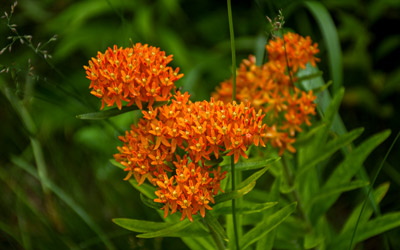
Butterfly milkweed (Asclepias tuberosa)
A compact and long-blooming plant, butterfly milkweed gets its name by being one of the primary host plants for monarch and queen butterflies. The flowers of the plant bloom in orange–red to orange–yellow clusters beginning in early July and lasting throughout the month into August. These beautiful New England natives stand out among green backdrops in the summer and can often be found in meadows or grassland areas.
Location(s): Wildlife Refuge Pond, Garden of Inspiration, parking lot meadow, and by the Belvedere

Daylily (Hemerocallis spp. and cultivars)
Daylilies, true to their name, are known for explosive, short-lived displays. While they add pops of color to New England gardens around mid-July, each bloom only lasts for about 24 hours. The flowers are usually funnel or bell-shaped and have three petals, three sepals, and six stamens. The Hemerocallis genus features around 15 species of the herbaceous perennials. They are native to Asia and central Europe but have been cultivated to the point that most daylilies sold are entirely hybrid.
Location(s): Primarily in the formal garden spaces such as the Lawn, Secret, and Winter Gardens, Garden of Inspiration, and along the Perennial Path/Beneficial Border

Lily (Lilium spp. and cultivars)
Native to Europe, North America, and Asia, lilies come from a genus of about 100 species. The bulbous perennials feature six petal-like parts and an assortment of shapes. The flowers of this plant are fragrant and come in a wide range of colors other than blue. The easiest way to tell lilies apart from daylilies — two flowers who commonly get mistaken for one another — is to look at their leaves. A lily will have a single stem will whirling leaves while a daylily has Mutiple stems with leaves coming from its base.
Location(s): The Secret Garden and Winter Garden
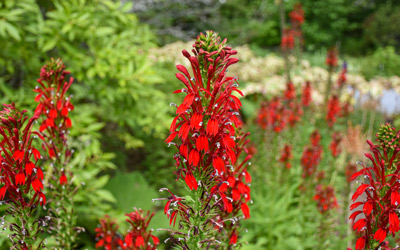
Cardinal flower (Lobelia cardinalis)
A hummingbird favorite, cardinal flower boasts a bright red color when in bloom. Tall spires and tubular blossoms are key characteristics of the plant. Cardinal flowers have several cultivars that can produce different colored blooms like indigo or purple. These plants have a relatively short bloom period but can persist for weeks depending on weather conditions.
Location(s): Secret Garden, Entry Garden, Garden of Inspiration, The Ramble
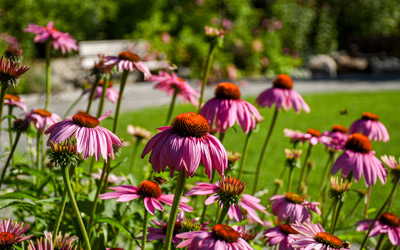
Coneflower (Echinacea purpurea, E. pallida and cultivars)
A popular perennial, coneflowers bloom from June through August with some blooms occurring into early fall. The genus Echinacea includes seven species all native to eastern and central North America. Today’s coneflowers are modern cultivars of an old-fashioned meadow flower. The plants are great for local pollinators and, come fall and winter, seedheads offer food for many bird species.
Location(s): Throughout the Garden, primarily the Lawn Garden and Garden of Inspiration
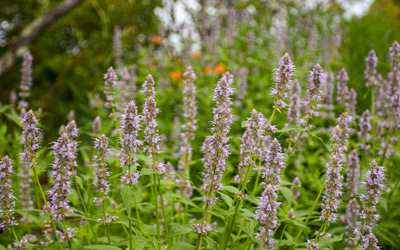
Giant hyssop or hummingbird mint (Agastache spp. and cultivars)
Agastache is a genus of about 30 species, most native to North America. The small purple-blue flowers form in dense spikes and have foliage that smells like anise or licorice. With a bloom period from July through September, the plants attract many pollinators, including bees and butterflies.
Location(s): Lawn, Cottage, and Secret Gardens as well as the Garden of Inspiration

Rose (Rosa spp. and cultivars)
Roses are primarily native to the temperate regions of the Northern Hemisphere, with the majority native to Asia. The Rosa genus consists of over 100 species of perennial shrubs. Wild roses typically can be found with five petals, while cultivated roses can double that amount. An iconic flower, the rose is the national flower of the United States and is often seen as a symbol of passion and love.
Location(s): Secret Garden, Orangerie, and Garden of Inspiration
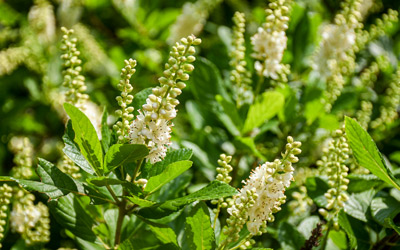
Sweet pepperbush (Clethra alnifolia cultivars)
These deciduous shrubs are native to swampy woodlands, wet marshes, stream banks, and shores from the coast of Maine to Florida and west to Texas. The densely branched shrub will bloom in mid to late summer with sweet-smelling, fragrant white or pink flowers. The flowers attract pollinators such as bees and butterflies.
Location(s): Lawn and Secret Gardens, Garden of Inspiration, and The Court

Blazing star (Liatris spicata cultivars)
This tall, upright perennial can be found in low grounds, meadows, and marshes. Deep purple flowers bloom atop flower stalks that arise from green leaves in the summer. Belonging to the aster family, blazing star have disk flowers but no ray flowers. The flowers attract hummingbirds, butterflies, and other pollinators, and once the seeds appear they attract many kinds of birds.
Location(s): Winter, Entry, and Lawn Gardens, and Garden of Inspiration
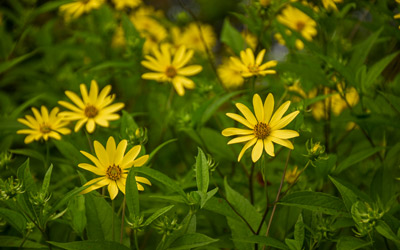
Perennial sunflower (Helianthus ‘Lemon Queen’)
This hybrid perennial sunflower can grow up to eight feet tall and almost as wide. The flowers, lemon-colored sunflowers, appear from July to the first frost. Like other Helianthus species, the perennial sunflower attracts butterflies and bees.
Location(s): Along the Perennial Path/Beneficial Border
